The value of an objective standard
We are no longer building saddle trees, but we have two videos about how Western saddles fit horses available on our westernsaddlefit.com website.
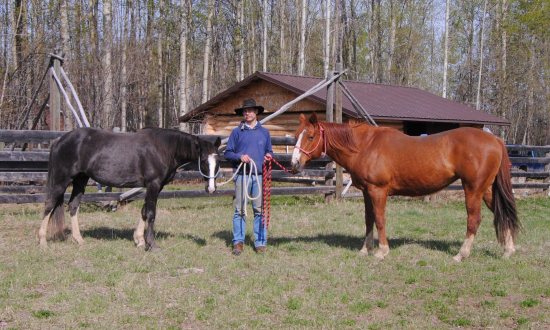
We've learned a lot from using the Dennis Lane Equine Back Profiling System over the last few years, but lately its usefulness was brought home to us again. We have two horses on the place at the moment. Dancer is our 12 year old, 16 hand QH mare. Misty is a loaner to us to keep Dancer company - and inside the fences. (Yes, there is a story there...) She is also 12 years old and is supposed to be a Tennessee Walking Horse, though since she has a varied history and no papers, we don't know how pure that might be.
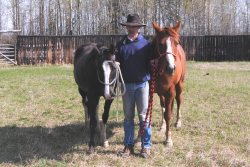 |
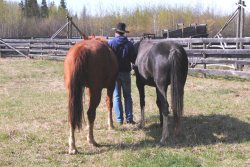 |
As you can see, Misty is much smaller and of a slighter build than Dancer. Hoof size, leg size, volume of muscle, breadth of hip - just a much smaller horse overall. I see this as a good thing as I'm not into mountain climbing, and Dancer can be a pretty tall mountain some days. (I've always thought that one of the most unfair things in the world is that the people with the longest legs also get the longest stirrups! Once, when Rod had to mount in my saddle, he commented on how high the stirrups were. I told him to try to get into them with legs 6" shorter than he was using and see how much fun that was...) Besides that, my engagement-ring/wedding-present-from-Rod saddle is a 3 3/4 inch hand hole with 90 degree bars, which was the standard Julian Tubb was using for ranch horses in 1990 when we got married. So it would fit a narrower horse better.
Then we pulled out the Dennis Lane cards to see how their backs compared.
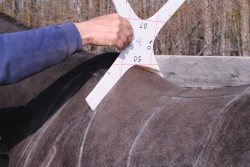 |
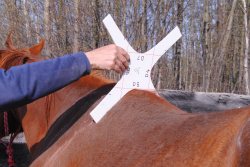 |
Hmmm... At the A position - right behind the shoulder blades - they are both D5. Interesting...
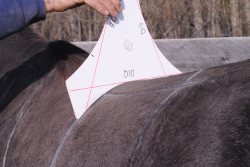 |
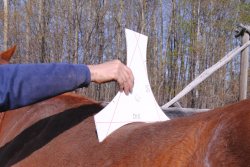 |
At B - the low point of the back - Misty was a D10, which is the largest size currently in the system. That is interesting, since she isn't fat (in fact, she was a bit on the thin side during the winter) and for such a narrow bodied horse I would have expected her to be smaller. But when you look at her, she is flatter and rounder across the back than a lot of bigger horses.
Dancer was actually a bit larger than D10. It was close, but the ends of the cards pressed in a bit and there was a bit of a gap in the center. We used the C cards at B and found that C9 actually fit her quite well there. (By the way, you can use the cards at the "wrong" spots as the shapes still often match. So long as people at both ends of the phone know which card is being used, it still communicates the shape of the horse - which is what the system is all about.) But the difference wasn't huge between the horses. Interesting...
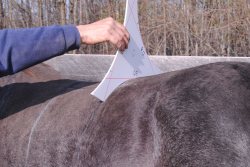 |
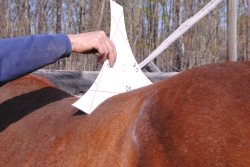 |
At C - 8" back of B, which puts it over the loin, both horses were D9. Interesting...
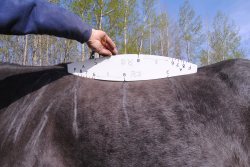 |
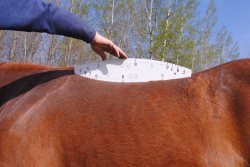 |
When it came to rock, Dancer was an R3. When Dennis first put out his system, he only had R12 (most rock), R9 (less rock) and R6 (even less rock). He did have a pattern for R3 but since it was so rare in his experience, he didn't put it in the set of cards. He has since added it because a number of people including us have found that there are a fair number of horses, in North America at least, that are flatter than R6. In fact, while his average rock in Australia is R9, ours is R6. So in the newer sets there is a flatter card - an R3. And that fit Dancer well.
Misty actually came in between an R6 and an R3. We have pretty consistently heard that gaited horses have flatter backs (less rock) than some other breeds. We haven't found this to be true in all cases. We have found that horses vary within a breed far more than they do between breeds. So when it comes to rock, these two are very close as well. Interesting...
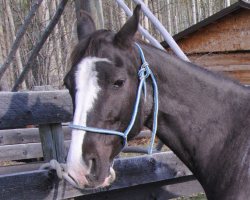 |
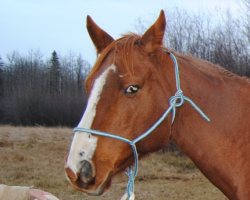 |
In fact, when you look closely, there are a lot of similarities between these two horses...
Again, this really showed us that saddle fit isn't about size or height or thickness of bone or volume of muscle. Fitting a saddle is all about shape. And an objective standard to compare shape between horses is invaluable, especially when there is so much optical illusion that occurs when you look at horses' backs (and saddle trees too, for that matter). So one saddle will obviously work very well on both these horses - but not mine. Now, knowing what we found, maybe we need to plan for Rod to build me a wider saddle to match the one he built for himself...
